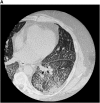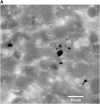Pulmonary alveolar proteinosis in workers at an indium processing facility
- PMID: 20019344
- PMCID: PMC3159086
- DOI: 10.1164/rccm.200907-1022CR
Pulmonary alveolar proteinosis in workers at an indium processing facility
Abstract
Two cases of pulmonary alveolar proteinosis, including one death, occurred in workers at a facility producing indium-tin oxide (ITO), a compound used in recent years to make flat panel displays. Both workers were exposed to airborne ITO dust and had indium in lung tissue specimens. One worker was tested for autoantibodies to granulocytemacrophage-colonystimulating factor (GM-CSF) and found to have an elevated level. These cases suggest that inhalational exposure to ITO causes pulmonary alveolar proteinosis, which may occur via an autoimmune mechanism.
Figures










Comment in
-
Pulmonary alveolar proteinosis associated with dust inhalation: not secondary but autoimmune?Am J Respir Crit Care Med. 2010 Mar 1;181(5):427-8. doi: 10.1164/rccm.200912-1800ED. Am J Respir Crit Care Med. 2010. PMID: 20185750 No abstract available.
-
Pulmonary alveolar proteinosis in workers at an indium processing facility.Am J Respir Crit Care Med. 2010 Aug 15;182(4):578; author reply 578-9. doi: 10.1164/ajrccm.182.4.578. Am J Respir Crit Care Med. 2010. PMID: 20713641 No abstract available.
-
Indium-tin oxide does not induce GM-CSF autoantibodies.Am J Respir Crit Care Med. 2011 Sep 15;184(6):741; author reply 741-2. doi: 10.1164/ajrccm.184.6.741. Am J Respir Crit Care Med. 2011. PMID: 21920929 No abstract available.
References
-
- Homma T, Ueno T, Sekizawa K, Tanaka A, Hirata M. Interstial pneumonia developed in a worker dealing with particles containing indium-tin oxide. J Occup Health 2003;45:137–139. - PubMed
-
- Homma S, Miyamoto A, Sakamoto S, Kishi K, Motoi N, Yoshimura K. Pulmonary fibrosis in an individual occupationally exposed to inhaled indium-tin oxide. Eur Respir J 2005;25:200–204. - PubMed
-
- Watanabe WT, Ettensohn DB, Jhung JW, Roggli VL. Pulmonary alveolar proteinosis associated with occupational indium exposure [abstract]. Chest 2002;122:246S–247S.
-
- Medvedovski E, Alvarez N, Yankov O, Olsson MK. Advanced indium-tin oxide ceramics for sputtering targets. Ceram Int 2008;34:1173–1182.
-
- National Institute for Occupational Safety and Health (NIOSH). NIOSH pocket guide to chemical hazards. U.S. Department of Health and Human Services; 2005. DHHS Publication No. (NIOSH) 2005-149.
Publication types
MeSH terms
Substances
Grants and funding
LinkOut - more resources
Full Text Sources
Medical

